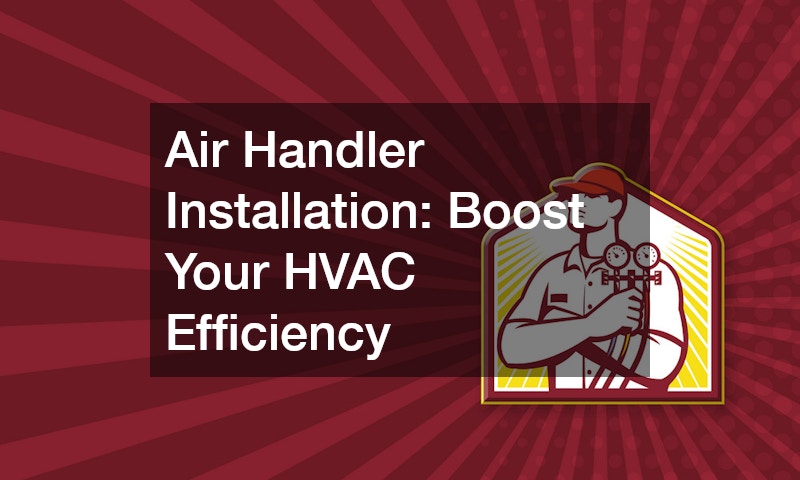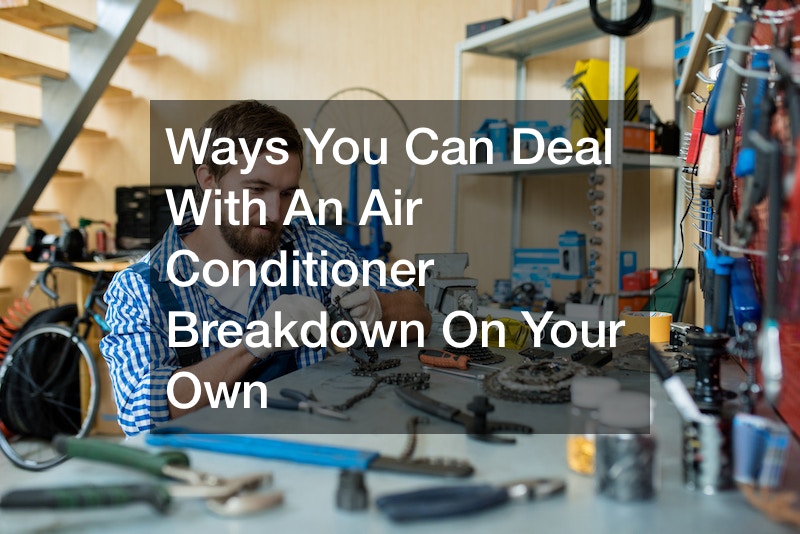Proper air handler installation is a pivotal component of optimizing your HVAC system. Often overlooked, the air handler serves as the backbone of air circulation, directly impacting the overall efficiency of your heating, ventilation, and air conditioning system. In an era where energy efficiency and cost-effectiveness are paramount, ensuring your air handler is correctly selected and installed can result in significant energy savings, improved air quality, and increased longevity of your entire system. From homeowners to commercial property managers, understanding the nuances of air handler installation helps make informed decisions that influence comfort and financial outcomes.
Additionally, this installation intersects with broader industries. From roofing to water damage restoration, many sectors depend on efficient HVAC systems for operational success. Moreover, economic growth in construction and real estate has increased demand for reliable systems, highlighting the relevance of proper installation. Whether you’re upgrading an outdated system or installing a brand new one, knowing the tools required, understanding potential challenges, and exploring DIY versus professional options will empower you to manage your HVAC infrastructure more effectively. And as industries expand, services like boom lift rental, compressed air systems, and equipment rental play essential roles in facilitating safe and efficient HVAC work. In this guide, we’ll explore everything you need to know about air handler installation, ac installation, hvac repair services, and more.

What is an Air Handler and How Does It Work?
An air handler is a crucial component of an HVAC system responsible for circulating and regulating air. It typically consists of a blower, heating or cooling elements, filter racks or chambers, and dampers. The blower draws in air through the system, where it is conditioned and then distributed throughout the building. Depending on the HVAC system type, an air handler may work with both heating and cooling units to manage indoor climate effectively.
Unlike furnaces, which generate heat through combustion, air handlers simply distribute conditioned air. This distinction makes them particularly compatible with systems like heat pumps. Their functionality also plays a significant role in enhancing indoor air quality, especially when combined with high-efficiency filters and features like UV lighting.
There are various models and brands on the market, including well-known names like Trane, Carrier, and Lennox, each offering specific benefits tailored to different needs. Whether made from aluminum or other durable materials, these units must be chosen based on size, capacity, and compatibility with existing HVAC infrastructure. Selecting the right model is the first step toward efficient ac installation and optimal system performance.
Why is Proper Air Handler Installation Important?
Proper air handler installation is essential for ensuring your HVAC system operates at peak performance. When installed correctly, an air handler enhances energy efficiency by minimizing airflow resistance and reducing energy consumption. This leads to lower utility bills and a smaller carbon footprint—critical concerns for homeowners and businesses alike.
Beyond energy savings, proper installation supports improved indoor air quality. A well-installed air handler prevents dust, allergens, and other contaminants from circulating, promoting a healthier living environment. It also helps in reducing moisture levels, an essential factor in preventing mold growth and the need for water damage restoration.
Moreover, when air handlers are properly fitted and calibrated, they help prevent common HVAC issues such as short cycling, uneven heating or cooling, and unnecessary wear on components. This contributes to the overall longevity of your HVAC system, reducing the frequency and cost of hvac repair services. Safety is another critical consideration—incorrect wiring or poor structural support can pose significant risks, especially in commercial settings.
Finally, a precise installation integrates seamlessly with other building systems. Whether your property includes spray foam insulation in walls or relies on aluminum ductwork, alignment and connection integrity are vital. Proper air handler setup is not just a technical requirement—it’s an investment in system efficiency, health, and long-term reliability.
How to Choose the Right Air Handler for Your Home?
Selecting the right air handler begins with understanding your HVAC system’s needs. Every home is different, with varying insulation levels, square footage, and climate requirements. For instance, homes using spray foam insulation may require smaller or more efficient air handlers due to minimized thermal loss. Start by determining the heating and cooling load of your property, which can be calculated using Manual J software or through a licensed HVAC professional.
Size and capacity are crucial factors. An undersized unit will struggle to maintain comfortable temperatures, while an oversized one may short cycle, leading to energy waste and wear. Energy efficiency ratings, such as SEER (Seasonal Energy Efficiency Ratio), also play a role. High SEER ratings mean better performance and cost savings over time.
Modern air handlers come with various features including variable-speed blowers, humidity control, and smart technology integrations. While these may add to the initial cost, they offer long-term benefits in comfort and efficiency. Aluminum coils, known for their durability and resistance to corrosion, are commonly recommended.
Budget is always a consideration, but it’s essential to view this as a long-term investment. While upfront costs vary, many manufacturers and utility companies offer financing options or rebates. Also, if your HVAC system is part of a broader home improvement or construction project, leveraging equipment rental options like boom lift rental can make installations safer and more efficient.

What Tools Are Required for Air Handler Installation?
Installing an air handler requires a range of tools, from basic to specialized. Standard hand tools such as screwdrivers, pliers, wrenches, and utility knives are foundational. These tools allow for the removal of panels, tightening of connections, and installation of brackets.
Specialized HVAC equipment is crucial. This includes vacuum pumps for refrigerant lines, refrigerant gauges, and leak detectors to ensure airtight seals. For connections involving compressed air systems or for securing ductwork, powered tools like cordless drills and torque wrenches come in handy.
Safety gear is non-negotiable. Gloves, safety glasses, masks, and sometimes hearing protection should be worn at all times. Depending on the installation location, fall protection or a boom lift rental might be necessary, particularly for rooftop or high-ceiling placements. These rentals are often essential on commercial sites where safety and reach are concerns.
Measuring and leveling instruments such as tape measures, laser levels, and digital thermometers are vital for ensuring the unit is correctly positioned and operating at the right temperatures. Electric tools, especially for wiring tasks, are also needed. Wire strippers, voltage testers, and crimping tools help ensure that electrical connections meet code and function safely. In all, proper tools and safety precautions lead to an efficient and hazard-free installation.
Step-by-Step Air Handler Installation Process
The air handler installation process begins with preparing the designated space. Whether in an attic, closet, or basement, the area must be clean, dry, and adequately supported. If spray foam insulation or other wall treatments are present, installers must ensure no obstruction exists for duct and electrical access. Floor reinforcements or vibration-absorbing platforms may also be installed, especially for larger units.
Next comes the placement of the air handler. It must be level and aligned with ductwork to avoid airflow restrictions. Aluminum mounting brackets or platforms provide durable, lightweight support. Once the unit is in place, ductwork is connected using sheet metal screws and foil tape to ensure airtight seals. Return and supply ducts must be aligned correctly to maintain system balance.
Electrical wiring is then connected. This includes power supplies, control wiring to the thermostat, and integration with other HVAC components. For safety and functionality, using tools suited for compressed air and electrical systems ensures tight, correct connections. If needed, equipment rental services can provide specialty gear for this stage.
The final steps include verifying refrigerant line connections, testing electrical components, and powering the unit to run diagnostic tests. Airflow rates, temperature differentials, and system pressures are measured to ensure everything operates within specifications. If issues arise, minor adjustments are made on-site, setting the stage for an efficient and reliable HVAC system.
Common Challenges and How to Overcome Them
Air handler installation can present several challenges, particularly in tight or older spaces. One of the most frequent issues is space constraints. Many installations occur in cramped attics or basements, requiring creative solutions. In such cases, flexible ductwork and compact aluminum units help accommodate spatial limitations without compromising performance.
Handling heavy equipment is another obstacle. Air handlers are bulky and often require multiple people or equipment rental, such as a boom lift, for safe positioning. This is especially true in commercial buildings or multi-story homes where vertical installation is necessary.
Electrical and wiring issues also arise frequently. Miswiring can result in system failure or even electrical hazards. Using proper diagnostic tools and ensuring clear labeling of connections can mitigate these problems. Ductwork alignment is another common challenge; poorly aligned ducts can reduce airflow and efficiency. Using laser levels and adjustable couplings helps ensure proper alignment.
Finally, calibration and testing errors can lead to underperformance. Skipping the testing phase or neglecting manufacturer guidelines might result in higher energy bills and frequent hvac repair services. Taking the time to perform thorough diagnostics at the end of installation is crucial for long-term success.

Maintenance Tips for Your Air Handler
Routine maintenance of your air handler is essential for preserving efficiency and extending its lifespan. Start with regular cleaning—dust and debris should be removed from coils, blowers, and filters. A vacuum and soft brush can help clean accessible areas, while professionals might use compressed air for deeper cleaning.
Scheduled inspections are vital. At least twice a year, a certified technician should check for signs of wear, refrigerant levels, and electrical integrity. This proactive approach helps avoid expensive hvac repair services and ensures the system runs smoothly year-round.
Filters should be replaced every 1–3 months, depending on usage and environmental factors like pets or pollen levels. Failure to change filters leads to reduced airflow and strain on the blower. Modern systems often include indicators to alert users when replacement is needed.
Monitoring and making seasonal adjustments to settings, such as humidity levels or fan speed, can optimize performance. Also, keep an eye out for common issues such as strange noises, uneven airflow, or spikes in energy consumption. Addressing these early prevents more significant problems later.
Lastly, if your home or facility also uses spray foam insulation or advanced duct materials like aluminum, ensure maintenance checks account for these systems. Their condition affects airflow and energy efficiency, making integrated inspections vital for holistic HVAC health.
Signs Your Air Handler Needs an Upgrade
Recognizing when your air handler needs an upgrade can prevent discomfort and reduce repair costs. A clear sign is decreased airflow. If rooms feel stuffy or if air doesn’t circulate well, it might indicate a failing blower motor or clogged coils.
Another indicator is an unexplained increase in energy bills. Older or malfunctioning units work harder to maintain temperature, consuming more power. In such cases, upgrading the unit as part of a broader ac installation may offer long-term savings and better efficiency.
Frequent repairs also suggest that the system is nearing the end of its life. If you’re calling for HVAC repair services more than once a season, it’s likely more cost-effective to replace the unit. Inconsistent indoor temperatures and excessive noise or vibration are additional red flags.
Aging air handlers may not integrate well with modern systems, particularly those using smart technology or advanced insulation like spray foam. Moreover, newer models are often built with corrosion-resistant aluminum components, making them more durable and efficient. Recognizing these signs early enables you to plan financially and ensure continuous comfort.
DIY vs. Professional Air Handler Installation
Deciding between DIY and professional air handler installation involves weighing several factors. DIY installation can save money upfront and offer a rewarding experience for skilled individuals. Online resources, accessible equipment rental services, and user-friendly models make this a viable option for some homeowners.
However, the benefits of hiring a professional often outweigh the cost. Licensed technicians bring expertise, ensure compliance with local codes, and offer warranties that protect your investment. Professionals also have access to specialized tools for compressed air systems, electrical work, and calibration.
In terms of cost comparison, DIY may seem cheaper but carries hidden risks like improper installation, which can lead to water damage restoration costs if condensation drains incorrectly. Time is another consideration—what may take a professional a few hours could take a DIYer days.
Safety is a critical concern. Without proper knowledge, you could face electrical hazards or structural damage. Liability is also a factor—some insurance policies may not cover damage from non-professional work. When in doubt, especially in complex setups or commercial spaces, investing in professional installation ensures peace of mind.

Understanding the Costs Involved in Air Handler Installation
The costs of air handler installation vary based on unit type, labor, and location. Initial costs typically include the price of the unit, which ranges from $700 to $2,500, and labor, which can add $1,000 or more. Factors like accessibility, complexity, and whether boom lift rental or specialized tools are required can also influence pricing.
Long-term energy savings are a major financial benefit. High-efficiency units reduce monthly bills and often pay for themselves within a few years. If combined with other upgrades like ac installation or aluminum ductwork, the overall system efficiency increases further.
Maintenance and repair expenses should also be considered. While newer models typically require less upkeep, occasional HVAC repair services are still necessary. Budgeting for annual maintenance helps avoid surprise costs.
Cost of upgrades, such as integrating smart thermostats or installing spray foam insulation, may be additional but yield better performance and savings. Finally, financing and incentives from manufacturers or local utilities can make installation more affordable. Exploring these options helps manage expenses while reaping long-term benefits.
Why Quality Air Handler Installation is Key to Long-Term HVAC Performance and Efficiency
Proper air handler installation is more than a mechanical task—it’s a strategic investment in the health, comfort, and efficiency of your home or business. From choosing the right unit to ensuring its seamless integration with your existing HVAC system, every step plays a vital role. When done correctly, this process delivers improved airflow, better air quality, reduced energy bills, and fewer calls for hvac repair services. It also complements other infrastructure elements like roofing, water damage restoration systems, and insulation.
Moreover, as industries grow and technology evolves, the demand for smarter, more efficient systems is increasing. The use of materials like aluminum, the integration of compressed air systems, and the reliance on equipment rental services such as boom lift rental all highlight the interconnected nature of modern building and maintenance practices. In this landscape, air handler installation isn’t just about comfort—it’s about supporting economic growth, ensuring sustainability, and maximizing return on investment.
Whether you opt for a DIY approach or hire professionals, the key lies in understanding your system’s unique requirements and making informed decisions. Use this guide as a roadmap for enhancing your HVAC infrastructure and achieving long-lasting results. With the right planning and execution, your air handler installation will serve as the cornerstone of a reliable, efficient, and future-ready HVAC system.



